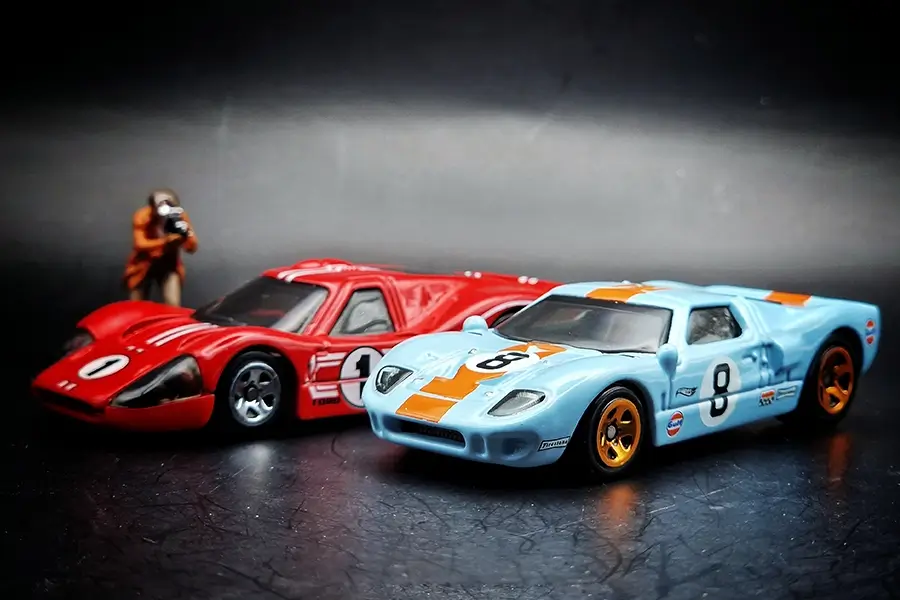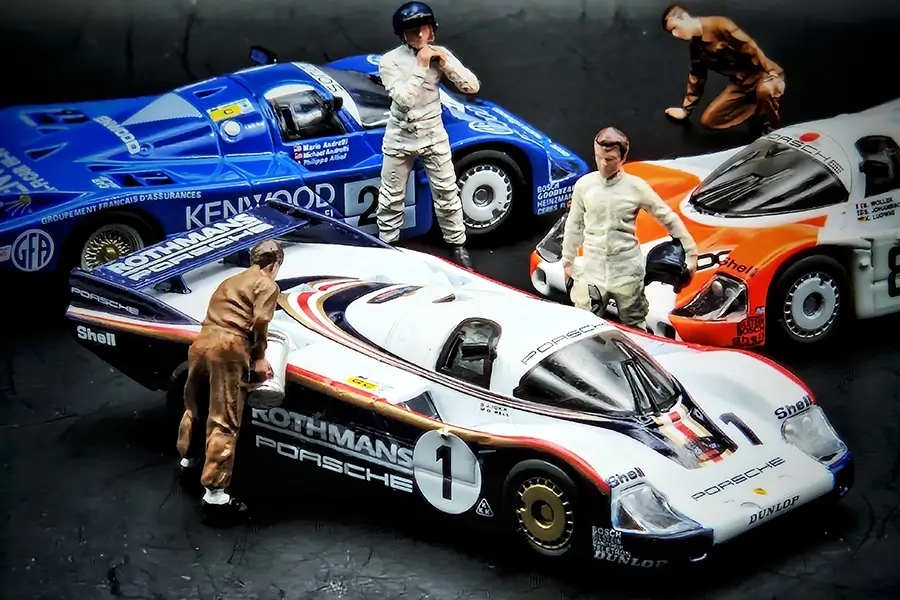
The most iconic cars: Legends of 100 years of Le Mans 24h – FEATURETTE
One hundred years of Le Mans 24 Hours
This weekend, one of the most famous and legendary races in the world will take place: the 24-hour race of Le Mans. Le Mans is a city of 150,000 inhabitants in north-western France, but above all it is also a cipher for full throttle, high-tech and adrenaline. In 1923, one hundred years ago, the endurance race "24 Hours of Le Mans" was started there for the first time - to this day one of the most spectacular motor sport events in the world. On the occasion of the centenary, we present some delicacies between 1950 and 2000 that have a very close relationship to the French race and its incomparable racing history!
The idea of the founders was quite simple: they wanted to find out which automobile was the most reliable and therefore called for a race that would last for a whole day, exactly 24 hours. Whoever covered the longest distance during this period won. The 24 Hours of Le Mans was held for the first time on 26th and 27th of May 1923, and the 100th anniversary race will start on 10 June 2023 - traditionally at 4 pm. The course is 13.5 kilometres long, notorious is the almost five-kilometre-long "Hunaudières Straight", on which speeds of more than 400 km/h were reached before the installation of a chicane in 1990.
1954: Jaguar D-Type by Matchbox

With its streamlined body including a characteristic fin, disc brakes and a semi-monocoque construction, the Jaguar D-type was technically ahead of its time. And in 1955, after second place the previous year, the British brand finally managed its first victory.
However, this was almost lost against the backdrop of the tragedy with more than 80 spectators who were getting killed due to a horrible racing accident. But in the following years, too, the
D-type was the benchmark at Le Mans.
In 1957, the car dominated the race, with Jaguar finishing in 1st, 2nd, 3rd, 4th and 6th place.
The Jaguar D-Type was powered by a 3.5-litre six-cylinder engine with an output of 250 hp. The car reached speeds of almost 300 km/h on the long straight at Le Mans.
1967: Ferrari 330 P4 by Hot Wheels

The 330 P4 was beautiful inside and out. Its four-litre V12 was a masterpiece by Franco Rocchi with a three-valve cylinder head, and the curved bodywork was even more beautiful than that of the P3. The car underlined its potential with a triple victory at the 24 Hours of Daytona.
Despite being more than 30 km/h slower than the Ford GT40 MkIV on the Hunaudieres straight, the P4 then fought valiantly at Le Mans, outlasting most of the American cars and coming home second and third. The P4 didn't win Le Mans, but in every other respect it met the requirements for a race car. This was not the only reason why the P4 was a popular model, which Hot Wheels released several times in different colour variants white it has been such an incredible eye catcher as well!
1969: Ford GT40 by Hot Wheels

The Ford GT40 was another great star at Le Mans, taking four consecutive victories between 1966 and 1969... and defeated Ferrari in a rivalry that went down in history. The 1966 story was memorized into an Oscar-winning film called Ford VS Ferrari. In 1968 and 1969, Team JWA raced the MK1 model in classic Gulf Oil livery. Pedro Rodriguez and Lucien Bianchi's victory in 1968 was followed by Jacky Ickx and Jackie Oliver's fourth Le Mans win for Ford in 1969. Hot Wheels has so far released several colour variants of the MK1 model as well as numerous colour variants of the 1967 MKIV.
1970: Porsche 917K by Spark

The 917 laid the foundation for Porsche's long success story at Le Mans, but hardly any year saw as many special liveries as 1971. It was the birth of the "PINK PIG", for example, which only finished in 32nd place, however. The battle for victory was fought out between two other 917Ks. Helmut Marko and Gijs van Lennep finally prevailed in their car with the Martini livery against Richard Attwood and Herbert Müller, who drove in Gulf colours. Already in 1970, several Porsche 917Ks were launched, also in the well-known Gulf colours. The model car manufacturer Spark also produced all Gulf models with the numbers #20, #21 and #22 - but it was the Porsche 917K painted in red with the number #23 in the legendary Salzburg livery that triumphed! Powered by a 4.5-litre twelve-cylinder engine with an initial output of 520 hp, the model proved to be a steadfast winning machine after the initially treacherous aerodynamics had been improved. In 1970, Hans Hermann and Richard Attwood took the first overall victory for Porsche at Le Mans with this car.
1983: Porsche 956 by Spark

The Porsche 956 was a sports car prototype that won all FIA Sports Car World Championship titles from 1982 to 1984, in both the drivers' and makes' classifications. It served until 1986 before being replaced by its successor, the 962. The 956 was driven by very well-known racing drivers such as Stefan Bellof, Jacky Ickx, Jochen Mass, Derek Bell, Hans-Joachim Stuck, Manfred Winkelhock and Vern Schuppan. The Porsche 962 and its predecessor 956 are among the most successful cars in the history of the 24 Hours of Le Mans, with six consecutive victories from 1982 onwards. Porsche's winning streak came to an end in 1988 with Jaguar's triumph. Through Spark, we are allowed to add numerous models to the collection, and Hot Wheels also contributed its share.
1989: Sauber C9 by Hot Wheels

In the early hours of Sunday morning in 1989, Team Sauber Mercedes took the lead at Le Mans for the first time. And it stayed that way until the race was waved off at 4pm in the afternoon. The driver trio Jochen Maas, Manuel Reuter and Stanley Dickens in the Sauber C9 won the endurance classic. The mid-engined race car was powered by a Mercedes V8 turbo engine that developed up to 800 hp. The car was measured at almost 390 km/h on the long straight. When Mattel announced that the Sauber C9 would be released in a Hot Wheels Mercedes diorama, the excitement was huge!
1991: Mazda 787B by Spark

The 1991 Le Mans 24-hour race ended with a double debut: for the first time, a Japanese car won the endurance race. And for the first time a car with a Wankel engine. The Mazda 787 B - whose 4-rotor Wankel engine mobilised an output of more than 700 hp - was driven by Johnny Herbert, Volker Weidler and Bertrand Gachot. With its legendary green-orange livery and screeching Wankel engine, the Mazda 787B was a striking presence. Which, however, remained a one-hit wonder. Never again was the Wankel-engined racer able to match this success, which was also made possible by the lack of stability of the superior Sauber-Mercedes C11. Nevertheless, the victory was a milestone in motorsport history. Through the model car manufacturer Spark, we were able to add this legendary piece to our collection.
1995: McLaren F1 GTR by Kyosho

The McLaren F1 GTR was entered in the famous and long-missing FIA GT Series, among many other championships, in the second half of the 1990s. Since 1995, the brand's 28 GTR race cars built in this way have won numerous international victories, including the 24 Hours of Le Mans in the same year. The McLaren F1 was able to win the race on its first start at Le Mans, which had never been achieved before. In addition, four other F1s took 3rd, 4th, 5th and 13th place. Models in the short version (right) were available from Hot Wheels, Scale Mini and Kyosho. The long-tail version (left) was exclusively produced from Kyosho.
1998: Porsche 911 GT1, Nissan R390 GT1, Mercedes CLK LM

The Nissan R390 GT1 was another very fast car born in the late 1990s to win the 24 Hours of Le Mans... but never succeeded due to mechanical problems.
The paintwork is nevertheless legendary.
The Mercedes-Benz CLK GTR was similarly legendary. This was powered by a 7.3-litre V12, similar to that of the Pagani Zonda, producing around 730 hp.
After winning the FIA GT, where it won the drivers' and constructors' titles in 1997 and 1998, it took part in the 24 Hours of Le Mans last year under the name CLK LM.
A participation that ended in a double failure.
The following year he returned with an unsuccessful development: the CLR (the "flying" Mercedes-Benz), where there are many videos on the internet about it.
The Porsche 911 GT1 went in the opposite direction to the Mercedes. Interestingly, unlike the Mercedes-Benz, the Porsche 911 GT1 didn't win the FIA GT.... but it did win Le Mans. This happened twice: in 1996 and 1998, the latter with the upgraded model shown above.
It is unmistakable that the 24 Hours of Le Mans wrote stories that could hardly be more legendary. All the more reason to be curious about who will lift the trophy a hundred years after the first start!


You May Also Like

Chibi Cars: A tooned modelcar world FEATURETTE
September 27, 2024
Tarmacworks LANCIA 037 RALLY – A legendary FEATURETTE
June 24, 2023
